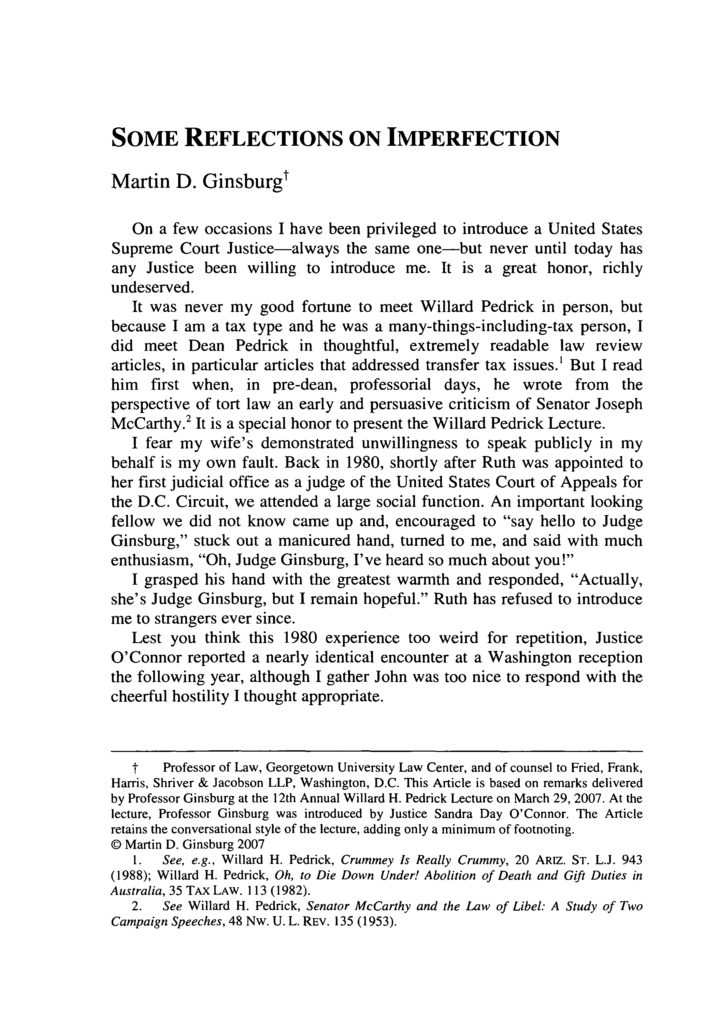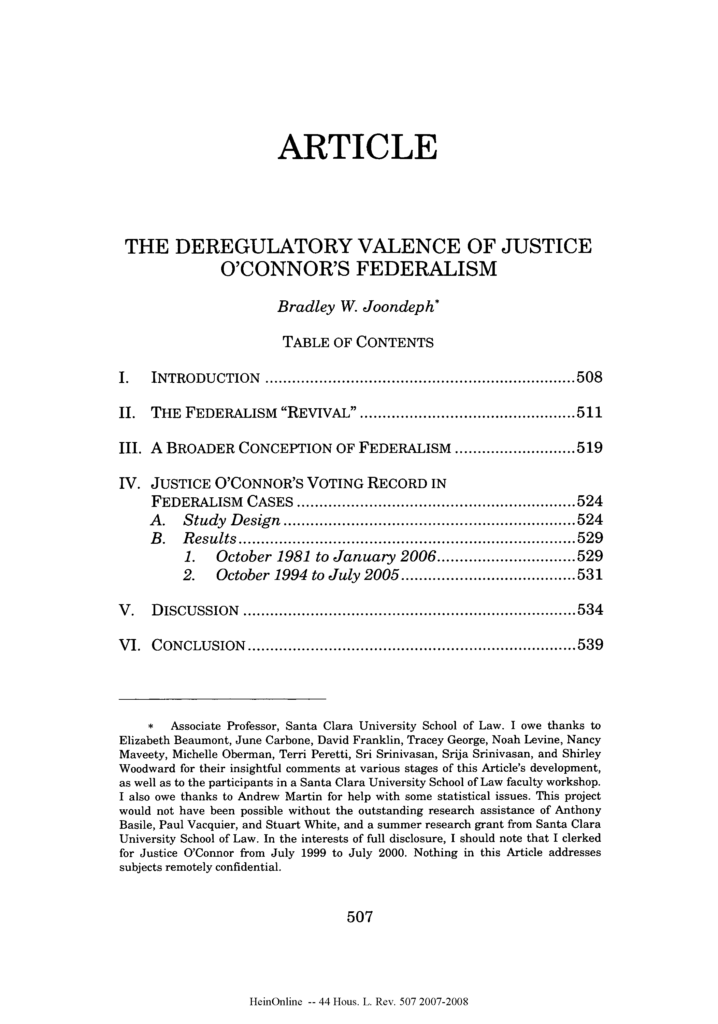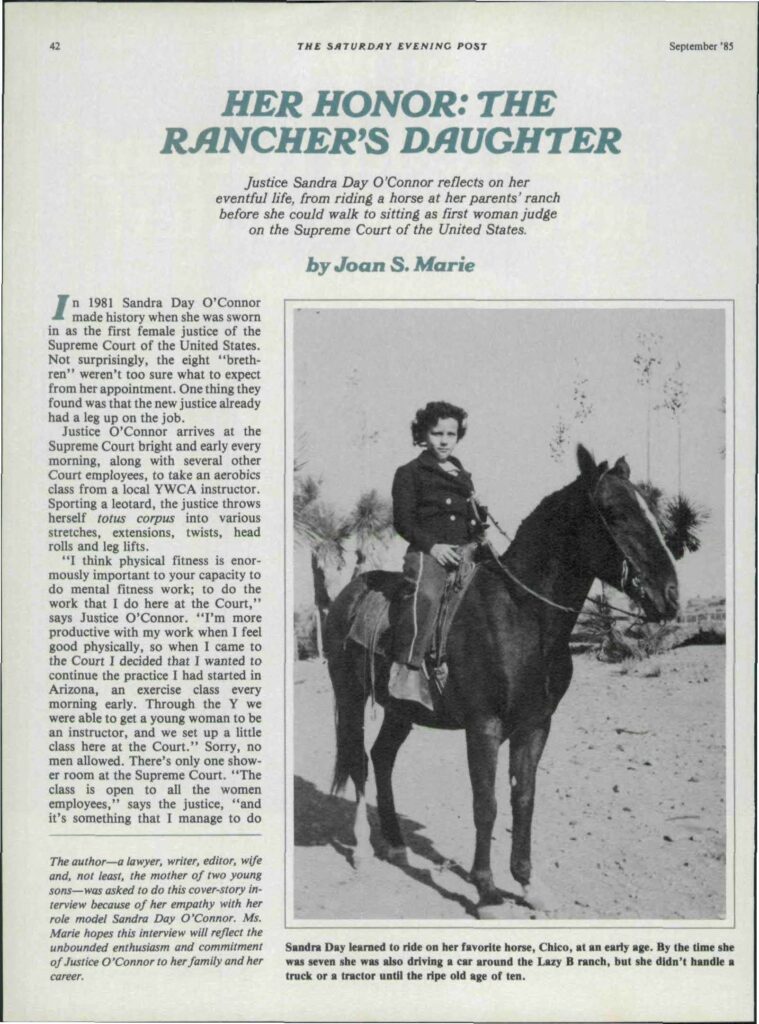Some Reflections on Imperfection
SOME REFLECTIONS ON IMPERFECTION
Martin D. Ginsburgt
On a few occasions I have been privileged to introduce a United States Supreme Court Justice-always the same one-but never until today has any Justice been willing to introduce me. It is a great honor, richly undeserved.
It was never my good fortune to meet Willard Pedrick in person, but because I am a tax type and he was a many-things-including-tax person, I did meet Dean Pedrick in thoughtful, extremely readable law review articles, in particular articles that addressed transfer tax issues.1 But I read him first when, in pre-dean, professorial days, he wrote from the perspective of tort law an early and persuasive criticism of Senator Joseph McCarthy.2 It is a special honor to present the Willard Pedrick Lecture.
I fear my wife’s demonstrated unwillingness to speak publicly in my behalf is my own fault. Back in 1980, shortly after Ruth was appointed to her first judicial office as a judge of the United States Court of Appeals for the D.C. Circuit, we attended a large social function. An important looking fellow we did not know came up and, encouraged to “say hello to Judge Ginsburg,” stuck out a manicured hand, turned to me, and said with much enthusiasm, “Oh, Judge Ginsburg, I’ve heard so much about you!”
I grasped his hand with the greatest warmth and responded, “Actually, she’s Judge Ginsburg, but I remain hopeful.” Ruth has refused to introduce me to strangers ever since.
Lest you think this 1980 experience too
Women as Supreme Court Candidates: From Florence Allen to Sandra O’Connor
Women as Supreme Court candidates: From Florence Allen to Sandra Day O’Connor
By Beverly B. Cook
America was not ready for a woman on the Supreme Court when a well-qualified Florence Allen was available in the 1930s. But by Sandra O’Connor’s day, America had changed its mind.
In the years between Florence E. Allen’s New Deal-era candidacy for the United States Supreme Court and the appointment of Sandra Day O’Connor as the first woman associate justice in September 1981, the proportion of women lawyers qualified for the Court did not change; the number of viable women candidates remained very small. But what did change over the intervening 50 years was the nation’s social climate and political culture.
[Photo caption: U.S. Chief Justice Warren Burger swears in Sandra Day O’Connor on September 25. Her husband, John, holds two family Bibles.]
Allen’s active self-candidacy faltered against the resistance of public opinion and the disinterest of the president. The public did not accept a woman’s seat on the Court, and the politicians, the legal professionals and the justices themselves did not perceive women lawyers as eligibles in the candidate pool. O’Connor’s route to the Supreme Court was smoothed by the recent acceptability of women in high public positions. The new public opinion toward female roles and the increasing importance of the women’s vote encouraged President Reagan to create a woman’s seat and then to look into the small pool of eligible women to find the one most
Closing Remarks: The Women at the United States Supreme Court
CLOSING REMARKS: THE WOMEN AT THE UNITED STATES SUPREME COURT
Thank you, thank you, Chief Justice Cantil-Sakauye for your inspiring, incredible words. Thank you to every person of my dream panel, and I have been dreaming about this panel for about eighteen months. I just can’t believe everyone made it and spoke so beautifully. Mary Alice, thank you for such a wonderful moderation, because we aren’t very moderate, but that was good. Thank you to the Supreme Court Fellows, Alumni Association, The Women Lawyers of Los Angeles and the National Association of Women’s Lawyers for your help sponsoring this event. Thank you to all the wonderful women of Southwestern; they are all congregated over there, for all your help. Thank you to Southwestern, to Dean Garth, thank you for that. And a very special thank you to all the people behind the scenes: to Deb Leathers, Joan Bautista, who has to be exhausted, Leslie Steinberg and see that cute guy by the camera, that’s Doug Snyder, he has really, really come through. I also want to thank that wonderful string quartet that was playing as we came off the elevator. I had them play because I know how much Justice O’Connor loves music. And first thing she did when she came up was to walk over to them. Now I know some of them pretty well; that second violinist, that little cute one, that’s my husband, Bill. And the first violinist, who is so spectacular, is Sonia Luna, and we have the best violist in the entire, entire city, Carol Summers, and
Remembering Rehnquist
Remembering Rehnquist
SANDRA DAY O’CONNOR
William Hubbs Rehnquist spent the last thirty-three years of his life as a member of the U.S. Supreme Court, fifteen as an Associate Justice and eighteen as Chief Justice. I met Bill when I was a freshman at Stanford in 1946. He was attending Stanford and working part time as a “hasher” at my dormitory during the evening meal. He amazed all of the young women by carrying such heavy loads of dishes on his tray. Perhaps that is how he learned to carry all those heavy loads in all of the years that followed. He was tall and good-looking, and he had a sharp sense of humor.
In 1950—after he had graduated Phi Beta Kappa from Stanford with a B.A. and an M.A., and received another M.A. from Harvard—he and I enrolled at Stanford Law School. He really put the “Bill” into the “G.I. Bill”: he had attained the rank of sergeant and had served in the Army Air Corps as a weather observer in the United States and North Africa. Like many of my classmates who had served in the war, he was serious about his studies and eager to get his LL.B. and practice law. Bill was clearly the brightest in our class, always prepared and willing to express his views when asked, and his conservative views were backed up by brilliant analysis. We also enjoyed bridge games, charades, and occasional movies. Little did either of us expect to serve on the Supreme Court one day.
Our class was very excited when Bill got a Supreme Court clerkship with Justice Robert





